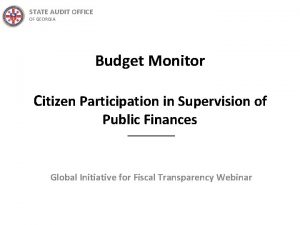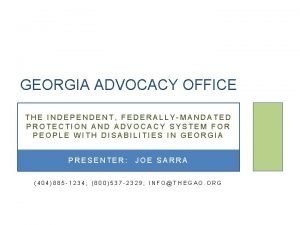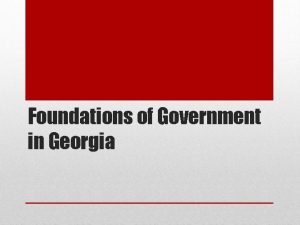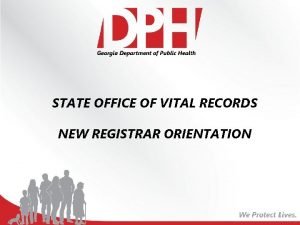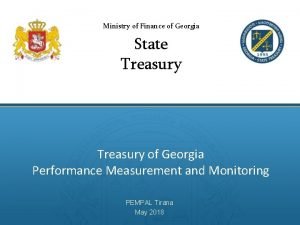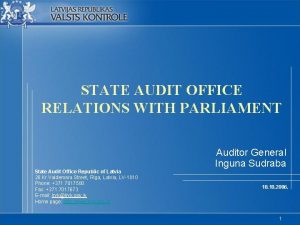State Audit Office of Georgia SAO EUROSAI Audit

















- Slides: 17

State Audit Office of Georgia (SAO) EUROSAI Audit Methodology Meeting 2018

Risk-based System for Annual Audit Planning Case of SAI Georgia 2

Strategic context and rationale Changes/reforms in recent years in the PFM system The need for directing SAO audit work onto the risks posing the greatest threat to the effectiveness of the PFM Introduction of the risk-based system for annual audit planning 3

SAO’s mandate Budget Spending Agencies (11 line ministries) ● ● ● SAOG has in total of 230 auditors Legal Entities of Public Law State Owned Enterprises Budget Spending Entities in Autonomous Republics of Georgia (Abkhazia and Adjara) ● Local self-governing units (LSGU) (67 municipalities) ● 4

Introduction of the Risk-Based System Representative Selection of Budgetary Entities Objective and Measurable Criteria Risk-Based Scorecard 5

Risk-Based System Description Risk Index Equation Impact Probability Risk Index Each of the factor indices itself comprises of several components defined as binary variables that take the value 0 or 1 and is calculated as the weighted average of the component scores using predefined weights’ matrix. The final Risk Index for the institution/program is calculated through the multiplication of the factor indices. 6

Risk Indices defined Impact The share of the entity’s/program’s appropriations within the total budgetary appropriations for the upcoming year Significance to the key stakeholders: Parliament, CSOs, citizens, donor organizations, etc. Probability Entity’s recommendation implementation rate Time Period elapsed from the last audit of entity/program High probability of risk identified at the institutional level Significant reforms/changes referring to the entity/program Material weaknesses/risks identified by the external sources 7

Impact Elements of the Risk-based System Assessment of Impact is defined through the combination of share of the budgetary appropriations and entity’s significance to key stakeholders - citizens and the Parliament. The share of the entity’s/program’s appropriations within the total budgetary appropriations for the upcoming year Significance of the SAO key stakeholders: citizens and/or the Parliament • The indicator aims to capture the quantitative aspects of the potential impact and is assigned the value of 1 if the percentage share exceeds 1% of the entity’s/program’s appropriations within the total budgetary appropriations • The indicator aims to capture the qualitative aspects of the potential impact takes the value of 1 if the industry/program represents the interest area of the citizens or the Parliament. 8

www. budgetmonitor. ge 9

Budget Monitor – Citizens’ Page Suggest opinions about deficiencies in the management of public resources and participate in setting up the annual audit plan Share information about corruption risks in public finances and take part in their mitigation process Participate in identifying the mort important audit areas

State Your Opinion About the Problem Choose Spending Agency Status Problem Description Problem Solution Contact Details (Optional) Upload Files Upload 11

Fight Corruption Choose spending agency What type of corruption did you discover? Describe the problem Contact Information (Optional) Upload Files Upload 12

Prioritize the fields you want to be audited 1. Economic development of local self-governing units ↨ 2. Accounting and management of state-owned property ↨ 3. Support for development of law enforcement agencies ↨ 4. Promoting the development of the state defense system ↨ 5. Infrastructure projects and programs ↨ 6. Health care and social assistance system ↨ 7. Support of education and science ↨ 8. Support of agriculture ↨ 9. Support of effective public administration and PFM reform ↨ 10. Management of culture and sport programs □ I am not a robot ↨ Send 13

Probability Elements of the Risk-based System Entity’s commitment to address the SAO recommendations • The indicator aims at assessing the progress made by the entities to address the weaknesses identified through the SAO audit reports Time Period elapsed from the last audit of entity/program • Indicator takes value of 1 if the entity/program has not been audited within the past two years and value of 0 otherwise High probability of risk identified at the institutional level • The indicator is based on the entity’s/program’s selfassessment that on its behalf rests on 55 questions covering the five core directions Significant changes/reforms referring to the entity/program Material weaknesses/risks identified by the external sources • Financing, operations or structure and/or reforms in the respective industry within the past two years. • Reported by the outside information sources such as international donor organizations, outside study panels and commissions etc. 14

Impact Composite Risk Index Matrix Extreme 1 0 0. 1 0. 2 0. 3 0. 4 0. 5 0. 6 0. 7 0. 8 0. 9 1 High 0. 6 0 0. 06 0. 12 0. 18 0. 24 0. 36 0. 42 0. 48 0. 54 0. 6 Medium 0. 4 0 0. 04 0. 08 0. 12 0. 16 0. 24 0. 28 0. 32 0. 36 0. 4 Low 0 0 0 0. 1 0. 2 0. 3 0. 4 0. 5 0. 6 0. 7 0. 8 0. 9 1 Low Medium 0 High Extreme Probability 15

Challenges ●Integration of Annual Audit Planning in the IT system ●Limited resources for comprehensive risk analysis ●Improvement of the existing methodology so that it adequately responds to the main audit requirements 16

Thank you
 Eurosai
Eurosai State audit office of georgia
State audit office of georgia Connecticut state comptroller
Connecticut state comptroller Georgia advocacy office
Georgia advocacy office Georgia state success academy
Georgia state success academy Georgia state motto
Georgia state motto Georgia state orientation
Georgia state orientation Financial aid mga
Financial aid mga Georgia flag pledge
Georgia flag pledge Tadra is an acronym for georgia’s
Tadra is an acronym for georgia’s Beta convention louisiana
Beta convention louisiana Gavers vital records
Gavers vital records Fcclainc
Fcclainc Fcclainc org
Fcclainc org Georgia state treasury
Georgia state treasury Georgia state seal image
Georgia state seal image What's georgia's state motto
What's georgia's state motto Marion morisson
Marion morisson

